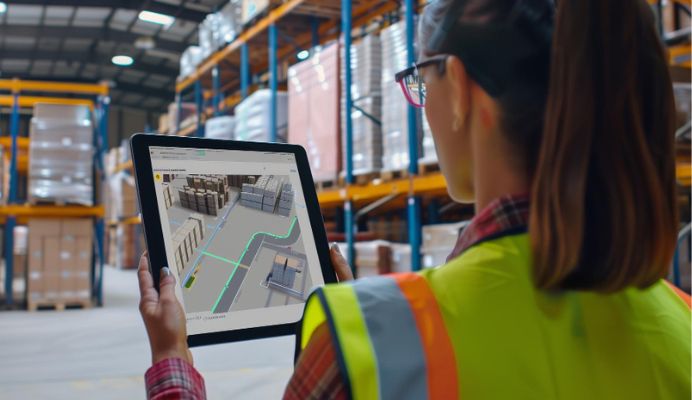
What is AI Route Planning and Why it Matters for Modern Logistics?
Introduction
Logistics has become the backbone of global commerce. From same-day e‑commerce deliveries to complex freight movements across continents, the pressure on supply chains has never been greater.
Customers expect speed, reliability, and transparency—while businesses face mounting challenges like rising fuel costs, urban congestion, and sustainability regulations.
Traditional route planning methods that rely on static maps, manual scheduling, or outdated software are no longer sufficient to meet the needs of modern logistics. This is where AI-powered route planning changes the game.
By harnessing real-time data, predictive analytics, and machine learning, AI can optimize delivery routes in ways that not only save time and money but also transform how logistics companies operate.
How does AI Route Planning Work?
AI route planning goes beyond finding the shortest path between two points. Instead, it dynamically analyzes vast amounts of data like traffic conditions, delivery constraints, and even unpredictable events. This is used to determine the most efficient and reliable route.
Here’s how it works step by step:
1. Data collection and integration
AI-powered systems pull information from multiple real-time and historical data sources, such as:
- GPS signals and telematics from vehicles
- Traffic patterns (congestion, rush hours, accidents, road closures)
- Weather forecasts affecting road conditions
- Delivery constraints such as time windows, vehicle capacity, and driver schedules
- Customer preferences like contactless delivery or specific time slots
By connecting to cloud-based platforms, AI can continuously update and refine its knowledge base.
2. Machine learning and predictive models
AI doesn’t just react to current conditions; it learns from the past. Machine learning algorithms analyze historical trends to make accurate predictions about future road and demand conditions. For example:
- Predicting rush-hour traffic in a specific city
- Forecasting delivery surges during holiday seasons
- Anticipating likely bottlenecks caused by recurring construction projects
These predictive insights give businesses a head start in planning smarter routes before problems occur.
3. Optimization algorithms
AI uses advanced optimization techniques to weigh multiple factors simultaneously. Traditional route planning might only consider distance, but AI balances:
- Fastest vs. most fuel-efficient route
- Traffic density vs. delivery time requirements
- Road restrictions vs. vehicle type (e.g., truck size limits)
- Maximum productivity (more stops with fewer vehicles)
The result isn’t just the shortest path; it’s the ideal path, tailored to operational goals.
4. Real-time adjustments
One of the biggest advantages of AI route planning is dynamic rerouting. When unexpected events occur like heavy traffic, sudden weather changes, or canceled customer orders, the AI system can instantly recalculate and redirect drivers. This ensures minimal delays, cost savings, and an improved customer experience through accurate ETAs.
5. Seamless deployment across logistics systems
AI route planning is usually integrated into existing Transportation Management Systems (TMS) or fleet management solutions, often via APIs. This allows companies to scale effortlessly while ensuring drivers, dispatchers, and customers all receive consistent, real-time information.
Why is AI Route Planning important?
AI route planning is important because it addresses the complex challenges faced by modern logistics through enhanced efficiency, cost savings, and improved service quality.
Here are the key reasons why it matters:
- Efficiency and Time Savings: AI optimizes routes by considering real-time traffic, weather, and delivery constraints, enabling faster deliveries and minimizing delays, which is crucial for meeting tight delivery windows.
- Cost Reduction: By finding the most fuel-efficient routes and reducing unnecessary mileage, AI helps lower fuel consumption and vehicle maintenance costs, which directly impacts a company’s bottom line.
- Sustainability: Optimized routing leads to fewer miles driven and less idle time, reducing carbon emissions and supporting environmental goals amid increasing regulations and customer demand for greener logistics.
- Improved Customer Satisfaction: Accurate delivery estimates and reliable time windows enhance the customer experience, boosting brand loyalty in a competitive market where timely delivery is paramount.
- Scalability and Adaptability: AI systems dynamically adapt to changing conditions, such as traffic incidents or last-minute order changes, allowing logistics operations to scale without sacrificing performance or control.
- Addressing Industry Challenges: In a context of rising fuel prices, urban congestion, driver shortages, and higher customer expectations, AI route planning provides a vital competitive advantage by enabling smarter, more resilient logistics operations.
Challenges and considerations in AI route planning
While AI route planning offers significant benefits, implementing and leveraging it effectively comes with several challenges and important considerations:
- Data Quality and Availability: AI depends heavily on large volumes of accurate and up-to-date data from sources like GPS, traffic, weather, and delivery specifics. Incomplete, outdated, or inaccurate data can degrade route optimization results, creating inefficiencies instead of solving them.
- Integration Complexity: Most logistics operations already use multiple management systems (TMS, fleet tracking, ERP). Integrating AI route planning seamlessly with these existing platforms requires technical expertise and can be costly and time-consuming.
- Real-Time Adaptability vs. System Stability: While AI re-routing in response to live events is a powerful advantage, constant route changes can confuse drivers or dispatchers if not managed with clear communication and good user interfaces.
- Driver and Workforce Adoption: Transitioning from manual or traditional planning to AI-powered route management involves training drivers and dispatchers. Resistance to change or low digital literacy can slow adoption and reduce potential benefits.
- Privacy and Security Concerns: Handling detailed geographic, operational, and personal data raises cybersecurity and privacy issues. Companies must ensure strong data governance and compliance with regulations.
- Algorithm Transparency and Trust: AI decisions can sometimes appear as “black boxes” to human planners. Building trust requires transparency into how routes are planned and why certain recommendations are made.
- Cost and ROI Considerations: Deploying AI route planning solutions involves investment in software, infrastructure, and training. Companies need to evaluate clear return on investment timelines and align AI capabilities with their operational scale and complexity.
- Edge Case Management: AI performs best with repetitive, predictable data patterns. Unusual, complex scenarios such as ad-hoc delivery requests, irregular routes, or exceptional regulatory constraints may require human intervention or specialized adjustments.
The Future of AI Route Planning
AI route planning is evolving rapidly, and its future promises to reshape the logistics landscape even more profoundly. Here are some key trends and developments to watch:
1. Integration with autonomous vehicles and drones
As self-driving trucks, delivery robots, and drones become increasingly viable, AI route planning will play a critical role in coordinating these autonomous fleets. AI systems will manage routes not only for human drivers but also for fleets operating 24/7 without breaks, enabling faster, safer, and more efficient deliveries.
2. Fusion with IoT and smart sensors
The Internet of Things (IoT) will provide a constant stream of data from vehicle sensors, smart traffic lights, and even packages themselves. This real-time, granular data will empower AI route planners to make hyper-precise decisions, adapting instantly to conditions on the road, vehicle health, and customer preferences.
3. Expanded role in sustainable logistics
With heightened environmental regulations and consumer expectations, AI route planning will increasingly prioritize sustainability. Advanced algorithms will optimize routes to minimize fuel consumption and emissions, and support compliance with green logistics standards and low-emission zones in urban areas.
4. End-to-end automated delivery networks
The combination of AI, robotics, and advanced software will lead to fully automated delivery ecosystems, where goods move seamlessly from warehouse to doorstep with minimal human intervention. AI route planning will be the core engine driving efficiency, responsiveness, and scalability in these networks.
5. Enhanced predictive and prescriptive capabilities
Future AI models will become even better at anticipating disruptions before they occur—whether due to weather, traffic incidents, or sudden demand spikes—and prescribe proactive solutions. This shift from reactive to proactive route management will greatly improve reliability and customer satisfaction.
Conclusion
AI route planning is no longer a futuristic concept; it is a vital tool driving the transformation of modern logistics. By leveraging real-time data, machine learning, and advanced optimization algorithms, AI enables faster, more cost-effective, and environmentally responsible delivery operations.
As customer expectations rise and supply chains grow increasingly complex, the companies that embrace AI route planning will gain a crucial competitive edge.






